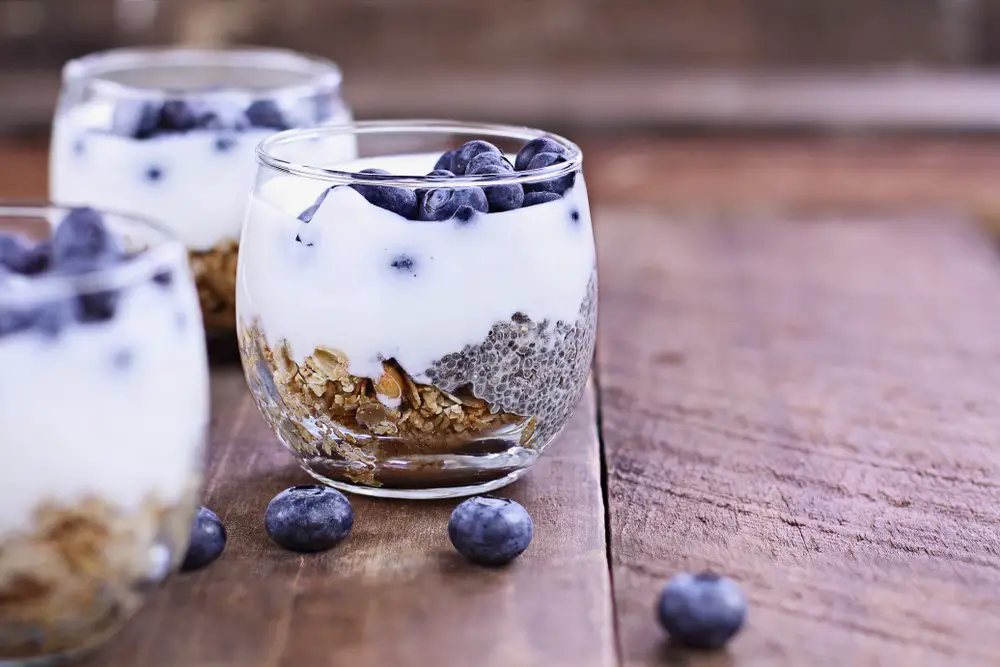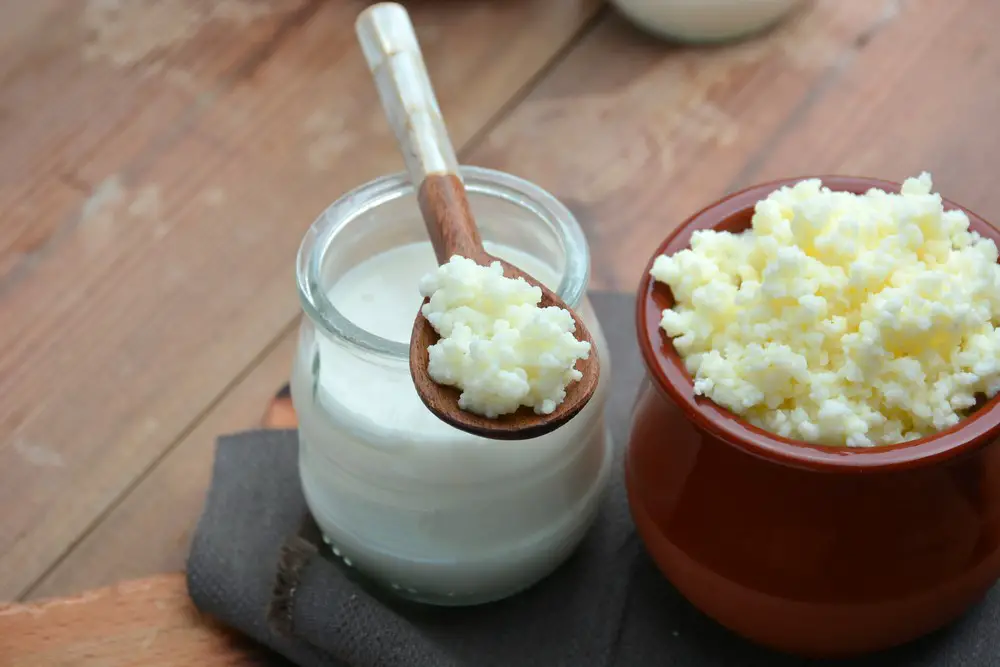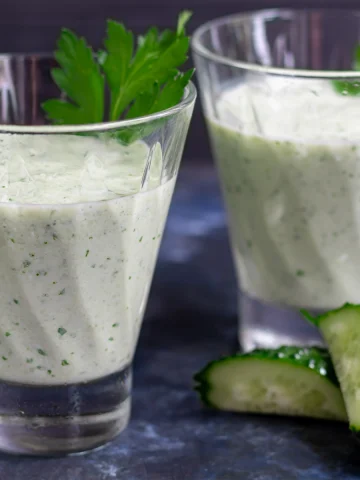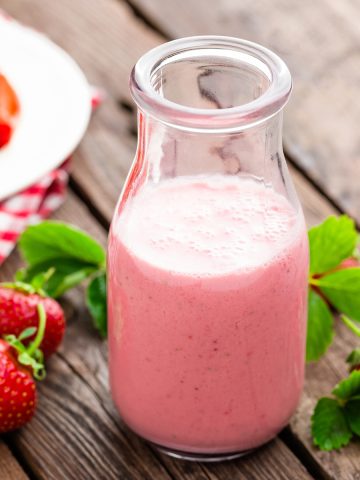Kefir and yogurt are both amazing dairy-based fermented foods. You've probably encountered the two when browsing your grocery store's yogurt section. But what is kefir? And how does it differ from conventional yogurt drinks?
In this article, I'll provide insight into what yogurt and kefir are and how they are made. I'll also offer some insight into the taste and texture of both foods and how they differ. Here's everything you need to know about yogurt vs. kefir.

Introduction to Yogurt and Kefir
Yogurt and kefir are both extremely popular fermented dishes made from dairy. Traditionally, both are sour and creamy, but you can find both in sweet fruit-flavored varieties. Each dish traces its origins back hundreds of years.
Yogurt's popularity first emerged in Turkey. In 1625, a writer named Samuel Purchas noted that Turks typically drank milk in the form of sour 'yoghurd.' The dish has a much earlier origin, though, as it was even pointed out in the first century AD that Anatolian goat herders would thicken and acidify their goat's milk.
Kefir has similar ancient origins. Kefir has even been found in ancient tombs. It became popular over 2,000 years ago with the nomadic herders who lived in the Caucasus mountains. Russia eventually took an interest in kefir, and after a woman named Irina Sakharova obtained kefir grains in 1908, the beverage quickly became popular worldwide.
Both drinks have grown in popularity recently because of their probiotic content. Now that it is understood that a healthy gut microbiome significantly influences other parts of physical and mental health, many people have made yogurt and kefir a central part of their diet.
What Is Yogurt?
Yogurt is a fermented dairy food or drink that allows lactic acid bacteria to feed on the sugars in milk. As the bacteria feed, they produce lactic acid, and this acid eventually causes the milk to thicken and coagulate, forming a deliciously creamy and sour product.
The process of making yogurt involves a few complicated steps. After heating and cooling the milk to eliminate germs, the yogurt has to be combined with a starter (made up of a mix of good bacteria strains) and gently heated for around 8 hours.
There are a few different types of yogurt that are popular. The most common type of yogurt found in stores is a common form of yogurt that contains flavorings and stabilizers, but while it might be tasty, it is different from the original product.
Another common type of yogurt is Greek yogurt. Greek yogurt is typically very simple and faithful to the type of yogurt produced during the conventional yogurt-making. It may be slightly flavored or contain a few additives, but it is thicker and more sour than regular yogurt.
Both types of yogurt are typically made with milk, but in recent years yogurts made from plant-based milk, such as soy and coconut milk, have also become popular. The milk is combined with a powdered starter culture containing several lactobacillus types and other beneficial bacteria.
What is Kefir?
Kefir is a fermented dairy drink made with a unique kefir grain culture. It's typically made from cow's milk, but it's common to encounter kefir made from sheep or goat milk. The grains contain a unique blend of bacteria and yeast that quickly culture and thicken the milk.
Several types of kefir exist. The most common type of kefir is milk kefir. It's known for having a sour and creamy flavor and is slightly more tangy than a conventional yogurt drink. Water kefir, which uses water with sugar and fruit instead of milk, is another common kefir similar to but lighter than kombucha.
Generally, kefir is made by combining fresh milk with live kefir grains. The milk and kefir can sit together at room temperature for several hours. During this time, the kefir grains' bacteria and yeast begin consuming the milk's sugars and producing lactic acid. Eventually, a thick and sour kefir drink.
Related: Best Kefir to Buy for Gut-Health

Differences in Taste and Texture
As you can see, kefir and yogurt are similar in many ways. They both involve dairy as their key ingredient and are fermented with the help of bacteria that produce lactic acid. Despite these similarities, kefir and yogurt have key differences that make them easy to tell apart.
To start, kefir is often much more sour and tangy than yogurt. Its flavor will resemble a strong Greek yogurt with added umami due to the yeast in the kefir grains. Yogurt often has a milder taste without any hints of yeasty flavor.
Yogurt is often much creamier than kefir, though the creaminess of a particular batch of yogurt will depend on what kind of milk is used. It may only have a slight hint of tartness, whereas kefir is more likely to have a robust sour flavor.
Yogurt is often much thicker than kefir as well. Kefir is typically only allowed to ferment enough that it becomes a drink with a viscous consistency. Yogurt's texture can vary from drink-like to extremely thick and creamy depending on how long it is heated.
Both have a very similar consistency when prepared for the same amount of time. They will have a creamy texture with bits of whey scattered throughout. Yogurt and kefir can be given a smoother texture if a very dense strainer is used to process and remove the whey.
Nutritional Profiles and Health Benefits
If you're considering making a batch of yogurt or kefir, it's easy to wonder which is healthier. Both are similar in many ways due to their shared ingredients, but their distinct fermentation processes result in two foods with slightly different nutritional profiles.
One hundred grams of regular whole-milk yogurt typically contains 61 calories and 3.5 grams of protein. With each serving, you can expect to get an extra 4.7 grams of sugar and carbs and 3.3 grams of fat. Yogurt also contains vitamin B12, calcium, phosphorus, and riboflavin (B2).
One hundred grams of whole-milk kefir typically contains 42 calories and 3.6 grams of protein. Your kefir will also contain 4.6 grams of sugar and carbs and 1.2 grams of fat with each serving. Kefir contains calcium, vitamin B12, phosphorus, riboflavin (B2), vitamin D, and magnesium.
The probiotics in kefir and yogurt vary more widely depending on your brand. The most common strains of bacteria in kefir and yogurt are Lactobacillus bulgaricus and Streptococcus thermophilus, but there are dozens of other strains of bacteria that you may encounter.
Both foods are associated with tons of potential health benefits. The most prominent benefit is improved gut health and digestion, as a healthier gut microbiome will allow you to eat without as much indigestion or bloating. You may also enjoy improved immune function and energy due to your healthy gut microbiome.
Incorporating Yogurt and Kefir into Your Diet
It's safe to say that yogurt and kefir are both superfoods, but you're not alone if you feel like you might get sick of them after eating a serving every day. Luckily, your imagination is the only limit to how you can enjoy eating yogurt and kefir.
Yogurt makes a great addition to sweet treats like smoothies and parfaits. Its thick texture makes it a suitable replacement for half-and-half or cream. You can make cakes and other baked treats much creamier and even use sour yogurt as a base for savory sauces and dressings.
Kefir has just as many incredible uses. Because of its thick texture, many people enjoy using kefir as a base ingredient for protein shakes and smoothies. You can use it instead of buttermilk in many baking recipes, and it can even be an ingredient in homemade ranch and other tangy sauces.
Related: What's the difference between kefir and buttermilk?

Frequently Asked Questions
Is kefir healthier than yogurt?
Kefir and yogurt are equally healthy when you purchase the right kind of kefir and yogurt. Both are made from similar ingredients but use a different blend of probiotic bacteria to ferment. Kefir may be healthier than store-bought yogurts that contain few probiotics and tons of stabilizers and sweeteners.
Can I substitute yogurt for kefir in recipes?
You can substitute yogurt for kefir in recipes. You should find a particularly sour yogurt (such as Greek yogurt) and thin it down to a viscous liquid consistency if you want it to be the most accurate replacement for the kefir.
What are the benefits of consuming probiotic-rich foods like yogurt and kefir?
The primary benefit of consuming probiotic-rich foods like yogurt and kefir is that your gut microbiome will be much healthier. You may experience reductions in symptoms like diarrhea and bloating due to your improved gut function and may even enjoy higher energy levels and improved immune function.
Can I make yogurt or kefir at home?
You can make yogurt and kefir at home. You will need to purchase kefir grains or a yogurt starter to begin. Buying the right equipment to gently warm and incubate the yogurt is recommended.
Can individuals with lactose intolerance consume yogurt or kefir?
While studies have shown that kefir improves lactose digestion and tolerance in adults with lactose maldigestion, you should proceed with caution. Try a little bit at a time and work your way up.
People with lactose intolerance often find yogurt much easier to digest than milk. This is because most yogurts contain live bacteria that can help break down lactose, so your body has less to process.
For example, one study about lactose digestion suggested that lactose intolerant people's digestive tracts retained 60% less undigested lactose when eating yogurt than when consuming the same amount of milk.
Individuals with lactose intolerance can consume yogurt and kefir, but taking Lactaid beforehand is best to prevent discomfort. You can also consider purchasing plant-based yogurts and kefirs to avoid the risk of digestive discomfort altogether.




